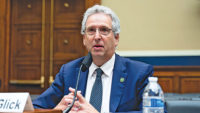Uncertainty over expected economic returns and long-term availability of proposed government tax incentives could jeopardize the estimated $12.3-billion plan by six big Alberta oil sands developers to build a carbon capture and storage facility they say would be the world’s largest, says a new report by energy sector research firm Wood Mackenzie. The first phase of the project, with a final investment decision estimated for 2025, aims to reduce the sector's carbon dioxide emissions by 10 to 12 million tons per year.
Members of project consortium Pathways Alliance “will be burdened with capital cost commitments” for a proposed, 400-km carbon pipeline, storage facilities and injection and monitoring wells, says the report. “Their own transport and storage tolls paid to Pathways will yield a return on this capital but is effectively robbing Peter to pay Paul; oil sands producers need to show a clear economic benefit beyond this” to approve the projects.
Oil giants Canadian Natural Resources, Cenovus Energy, Imperial Oil, Suncor Energy, ConocoPhillips Canada and MEG Energy make up the consortium. The group’s carbon capture and storage network will carry an estimated 1.1 billion liquid tonnes of CO2 from more than 20 oil sands facilities to an underground storage hub in northeast Alberta.
Oil sands sector emissions are about 12% of Canada's total greenhouse gases, with a goal to reach net zero by 2050 mostly through carbon capture and storage.
Front end design and engineering is underway for the hub, set to be located more than 1 km below ground, says the consortium. Pre-FEED work was completed by engineering firm Wood’s Calgary-based operation. Subsurface evaluation and environmental field work also are finished, with first-phase project commissioning estimated by late 2026, the alliance has said.
Canada’s carbon capture investment tax credit was announced in its 2021 federal budget but awaits enabling federal legislation. A spokesperson for Finance Minister Chrystia Freeland said carbon capture and storage “is essential to reducing Canada's emissions and we want to incentivize businesses to reduce their emissions as soon as possible."
Set to be retroactive to 2022, it would offer a tax credit of about 28% to 44% for an investment in carbon capture equipment, transportation, storage and usage in Alberta, Saskatchewan and British Columbia. Similar to credits offered in the U.S. under the 2022 Inflation Reduction Act, it also has provisions that require developers to pay project workers prevailing wages and provide apprenticeship opportunities to gain maximum credits.
Peter Findlay, Wood Mackenzie director of CCUS economics, says the duration of the government incentives is a key issue. “The real challenge for Canadian CCUS is not insufficient incentives—they are some of the most attractive in the world—but the uncertainty of their existence throughout project life," he says. “The value of most of these incentives could be changed by political whim at any point during the project life—even going to zero.”
Pathways Alliance President Kendall Dilling disagrees that Canada’s CCUS incentives are more favorable than in the U.S. “It’s also important to understand that Canadian oil producers already operate under a high carbon price environment. In the U.S., there is no corresponding federal carbon price.”
Proceeding with the project and long-term capital and operating investments involved depend on "having critical regulatory policies and substantial co-investment commitments from governments that will allow our industry to remain globally competitive while decarbonizing our production,” says Dilling. Wood Mackenzie agrees that if federal and provincial governments cannot collaborate to underpin this uncertainty, few carbon capture projects will move forward and most will be delayed and potentially cancelled, as the industry has threatened.
Findlay says the long term cost of oil also is a project challenge. “The overarching question is who between government and industry is willing to underwrite the political risk of that price over a project that will take three to five years to build after [its investment decision] and need to operate for 20 to 30 years?”
Pathways Alliance decarbonization investment was about $1.3 billion from 2021 to November 2023.
Mixed Views on CCUS Benefit
First Nations in the region planned for the hub are concerned about potential long-term impacts of injecting CO2 underground, with the project sited for about 100 km of their traditional territory, according to a CBC report. Environmental Defence, an advocacy group opposed to carbon capture and storage, calls it “a dangerous distraction being promoted by the oil and gas industry to prolong business as usual,” and is concerned about the long-term cost of tax credits to taxpayers. A recent independent Canada budget watchdog report says the original $3.4-billion credit cost estimate between 2022 and 2028 now is $4.2 billion.
But there are some smaller successes so far. The Quest carbon capture and storage project built by Fluor Corp. near Edmonton in the Athabasca oil sands region has been in commercial operation since 2015, and has “safely captured and stored eight million tonnes of CO2,” says a spokesman for Shell Canada Ltd.
Wood MacKenzie also predicts that the global carbon capture and storage pipeline would grow, with 119 projects aiming for final investment decisions in 2024, mostly in Europe and North America, representing the largest number to date. These projects collectively target 115 million tons per year of capture capacity and 240 million tons per year of storage capacity.
The research firm says the increase in project capacity estimated this year more than doubled compared to last year.
But the International Energy Agency said in a new report that companies should start "letting go of the illusion" that "implausibly large" amounts of carbon capture are the solution to the global climate crisis.






Post a comment to this article
Report Abusive Comment